Influence of Blade Wrap Angle on the Hydrodynamic Radial Force of Single Blade Centrifugal Pump
Abstract
:1. Introduction
2. Pump Model and Simulation Method
2.1. Pump Model
2.2. Simulation Method
2.3. Validation
3. Results and Discussion
3.1. Influence of Blade Wrap Angle on the External Characteristic
3.2. Influence of Blade Wrap Angle on Radial Force
4. Conclusions
- (1)
- Generally, the head and efficiency of the single-blade centrifugal pump are improved with the increase of blade wrap angle. With the increase of the blade wrap angle, the pump head tends to increase, and the H-Q curve becomes steeper, the pump efficiency increases gradually, but the high-efficiency area is narrowed. The P-Q curve becomes gentle with the increase of blade wrap angle.
- (2)
- The blade wrap angle has a significant impact on the radial force of the single blade centrifugal pump. When the blade wrap angle is less than 360°, the x component of the radial force is negative and the value is reduced with the increase of the wrap angle of the blade. When the wrap angle is larger than 360°, the x component of the radial force is positive and the value increases with the increase of the wrap angle. The y component of the impeller radial force has a maximum value when the wrap angle is 360° and 390°, and has a minimum value when the wrap angle is 300°.
- (3)
- Under part-loading conditions, the radial force of the single blade pump is significantly reduced with the increase of the blade wrap angle. When the wrap angle is smaller than 360°, the radial force decreases with the flow rate increase. In the condition that the wrap angle is larger than 360°, the radial force increases with the flow rate increase.
- (4)
- It suggested that the available blade wrap angle for single blade centrifugal pump should be between 360°and 420°, to achieve a better hydraulic performance and stable flow field.
Author Contributions
Funding
Conflicts of Interest
References
- Benra, F.K.; Dohmen, H.; Sommer, M. Periodically unsteady flow in a single-blade centrifugal pump: Numerical and experimental results. In Proceedings of the ASME 2005 Fluids Engineering Division Summer Meeting, Hoston, TX, USA, 19–23 June 2005; American Society of Mechanical Engineers: New York, NY, USA, 2005; pp. 1223–1231. [Google Scholar]
- Tang, S.; Yuan, S.; Zhu, Y. Convolutional Neural Network in Intelligent Fault Diagnosis toward Rotatory Machinery. IEEE Access 2020, 8, 86510–86519. [Google Scholar] [CrossRef]
- Stepanoff, A. Centrifugal and Axial Flow Pumps; Van Chong Book Company: New York, NY, USA, 1950. [Google Scholar]
- Biheller, H. Radial force on the impeller of centrifugal pumps with volute, semivolute, and fully concentric casings. J. Eng. Power 1965, 87, 319–322. [Google Scholar] [CrossRef]
- Chamieh, D.S.; Acosta, A.J.; Brennen, C.E.; Caughey, T.K. Experimental measurements of hydrodynamic radial forces and stiffness matrices for a centrifugal pump-impeller. J. Fluids Eng. 1985, 107, 307–315. [Google Scholar] [CrossRef] [Green Version]
- Adkins, D.R.; Brennen, C.E. Analyses of hydrodynamic radial forces on centrifugal pump impellers. ASME Trans. J. Fluids Eng. 1986, 110, 20–28. [Google Scholar] [CrossRef]
- Yun, H.; Brennen, C.E. Effect of Swirl on Rotordynamic Forces Caused by Front Shroud Pump Leakage. J. Fluids Eng. 2002, 124, 1005–1010. [Google Scholar]
- Brennen, C.E.; Acosta, A. Fluid-induced rotordynamic forces and instabilities. Struct. Control Health Monit. 2006, 13, 10–26. [Google Scholar] [CrossRef] [Green Version]
- Guelich, J.; Jud, W.; Hughes, S.F. Review of Parameters Influencing Hydraulic Forces on Centrifugal Impellers. Proc. Inst. Mech. Eng. Part A J. Power Energy 1987, 201, 163–174. [Google Scholar] [CrossRef]
- Boehning, F.; Timms, D.L.; Amaral, F.; Oliveira, L.; Graefe, R.; Hsu, P.L.; Schmitz-Rode, T.; Steinseifer, U. Evaluation of Hydraulic Radial Forces on the Impeller by the Volute in a Centrifugal Rotary Blood Pump. Artif. Organs 2011, 35, 818–825. [Google Scholar] [CrossRef] [PubMed]
- Alemi, H.; Ahmad Nourbakhsh, S.; Raisee, M.; Farhad Najafi, A. Development of new “multivolute casing” geometries for radial force reduction in centrifugal pumps. Eng. Appl. Comput. Fluid Mech. 2015, 9, 1–11. [Google Scholar] [CrossRef]
- Benra, F.K.; Dohmen, H.J.; Schneider, O. Calculation of hydrodynamic forces and flow induced vibrations of centrifugal sewage water pumps. In Proceedings of the ASME/JSME 2003 4th Joint Fluids Summer Engineering Conference, Honolulu, HI, USA, 6–10 July 2003; American Society of Mechanical Engineers: Hoston, TX, USA, 2003; pp. 603–608. [Google Scholar]
- Benra, F.K.; Dohmen, H.J.; Schneider, O. Measurement of flow induced rotor oscillations in a single-blade centrifugal pump. In Proceedings of the ASME/JSME 2004 Pressure Vessels and Piping Conference, San Diego, CA, USA, 25–29 July 2004; American Society of Mechanical Engineers: Hoston, TX, USA, 2004; pp. 167–174. [Google Scholar]
- Benra, F.K. Experimental investigation of hydrodynamic forces for different configurations of single-blade centrifugal pumps. In Proceedings of the 11th International Symposium on Transport Phenomena and Dynamics of Rotating Machinery (ISROMAC-11), Honolulu, HI, USA, 26 February–2 March 2006. [Google Scholar]
- Benra, F.K. Numerical and Experimental Investigation on the Flow Induced Oscillations of a Single-Blade Pump Impeller. J. Fluids Eng. 2006, 128, 783–793. [Google Scholar] [CrossRef]
- Aoki, M. Instantaneous Interblade Pressure Distributions and Fluctuating Radial Thrust in a Single-blade Centrifugal Pump. Bull. JSME 2008, 27, 2413–2420. [Google Scholar] [CrossRef]
- Nishi, Y.; Fujiwara, R.; Fukutomi, J. Design Method for Single-Blade Centrifugal Pump Impeller. J. Fluid Sci. Technol. 2009, 4, 786–800. [Google Scholar] [CrossRef] [Green Version]
- Nishi, Y.; Fukutomi, J.; Fujiwara, R. Radial Thrust of Single-Blade Centrifugal Pump. IJFMS 2011, 4, 387–395. [Google Scholar] [CrossRef] [Green Version]
- Nishi, Y.; Fukutomi, J. Effect of Blade Outlet Angle on Unsteady Hydrodynamic Force of Closed-Type Centrifugal Pump with Single Blade. Int. J. Rotating Mach. 2014, 2014, 1–16. [Google Scholar] [CrossRef] [Green Version]
- Tan, M.; Ji, Y.; Liu, H. Effect of Blade Wrap Angle on Performance of a Single-Channel Pump. Exp. Tech. 2018, 2018, 481–490. [Google Scholar] [CrossRef]
- Chen, J.; Shi, W.; Zhang, D. Influence of blade inlet angle on the performance of a single blade centrifugal pump. Eng. Appl. Comput. Fluid Mech. 2021, 15, 462–475. [Google Scholar]
- Tan, L.; Shi, W.; Zhang, D.; Zhou, L.; Wang, C. Numerical and experimental investigations of pressure fluctuations in single-channel pumps. Proc. Inst. Mech. Eng. Part A J. Power Energy 2018, 232, 97–415. [Google Scholar] [CrossRef]
- Jiang, Z.; Li, H.; Shi, G.; Liu, X. Flow Characteristics and Energy Loss within the Static Impeller of Multiphase Pump. Processes 2021, 9, 1025. [Google Scholar] [CrossRef]
- Yang, Y.; Zhou, L.; Shi, W.; He, Z.; Han, Y.; Xiao, Y. Interstage difference of pressure pulsation in a three-stage electrical submersible pump. J. Pet. Sci. Eng. 2020, 196, 107653. [Google Scholar] [CrossRef]
- Yang, Y.; Zhou, L.; Hang, J.; Du, D.; Shi, W.; He, Z. Energy characteristics and optimal design of diffuser meridian in an electrical submersible pump. Renew. Energy 2021, 167, 718–727. [Google Scholar] [CrossRef]
- Peng, G.; Huang, X.; Zhou, L.; Zhou, G.; Zhou, H. Solid-liquid two-phase flow and wear analysis in a large-scale centrifugal slurry pump. Eng. Fail. Anal. 2020, 114, 104602. [Google Scholar] [CrossRef]
- Li, X.; Jiang, Z.; Zhu, Z.; Si, Q.; Li, Y. Entropy generation analysis for the cavitating head-drop characteristic of a centrifugal pump. Proc. Inst. Mech. Eng. Part C J. Mech. Eng. Sci. 2018, 232, 4637–4646. [Google Scholar] [CrossRef]
- Tan, L.; Shi, W.; Zhang, D.; Wang, C.; Zhou, L.; Mahmoud, E. Numerical and experimental investigations on the hydrodynamic radial force of single-channel pumps. J. Mech. Sci. Technol. 2018, 32, 4571–4581. [Google Scholar] [CrossRef]

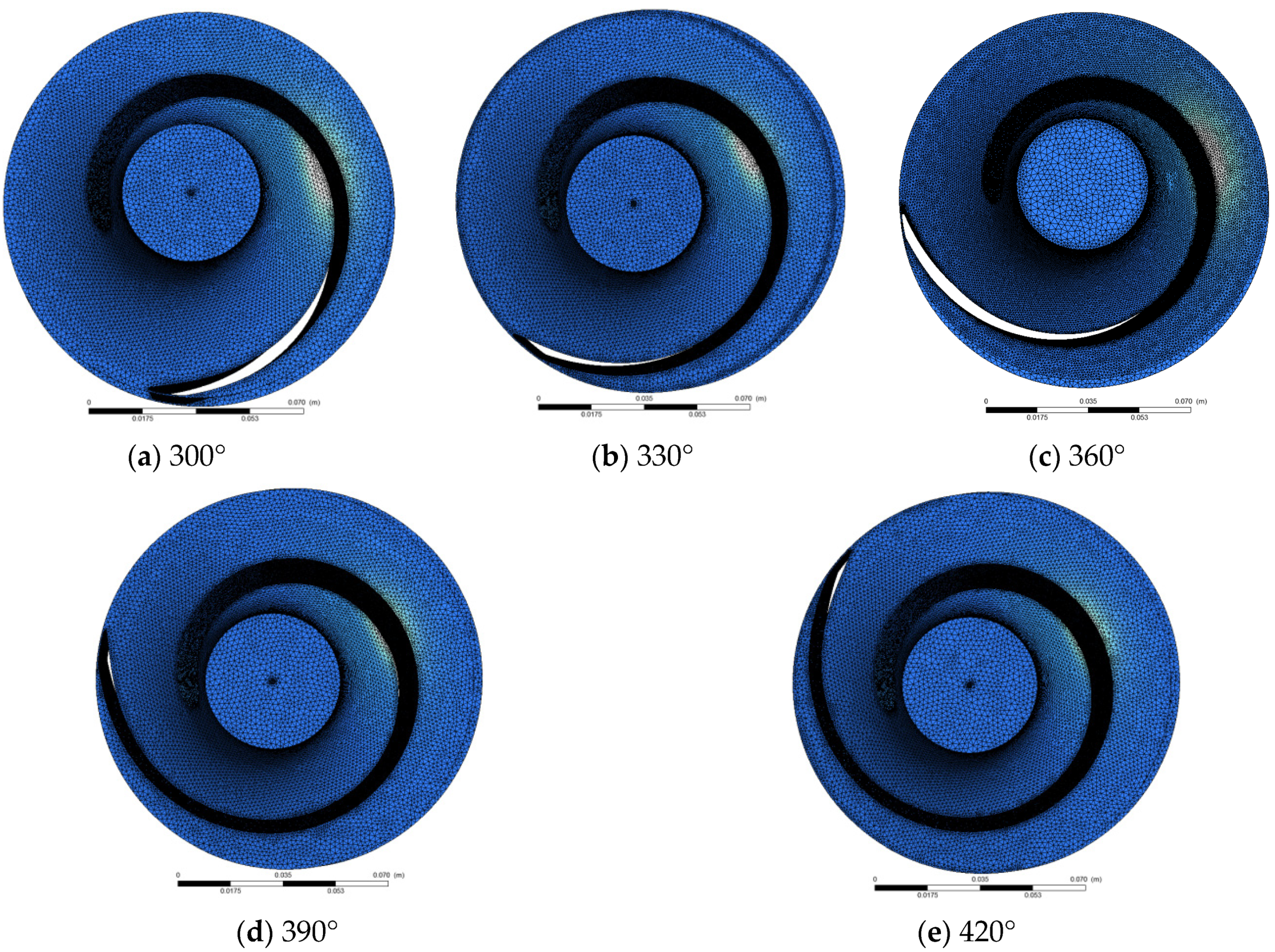
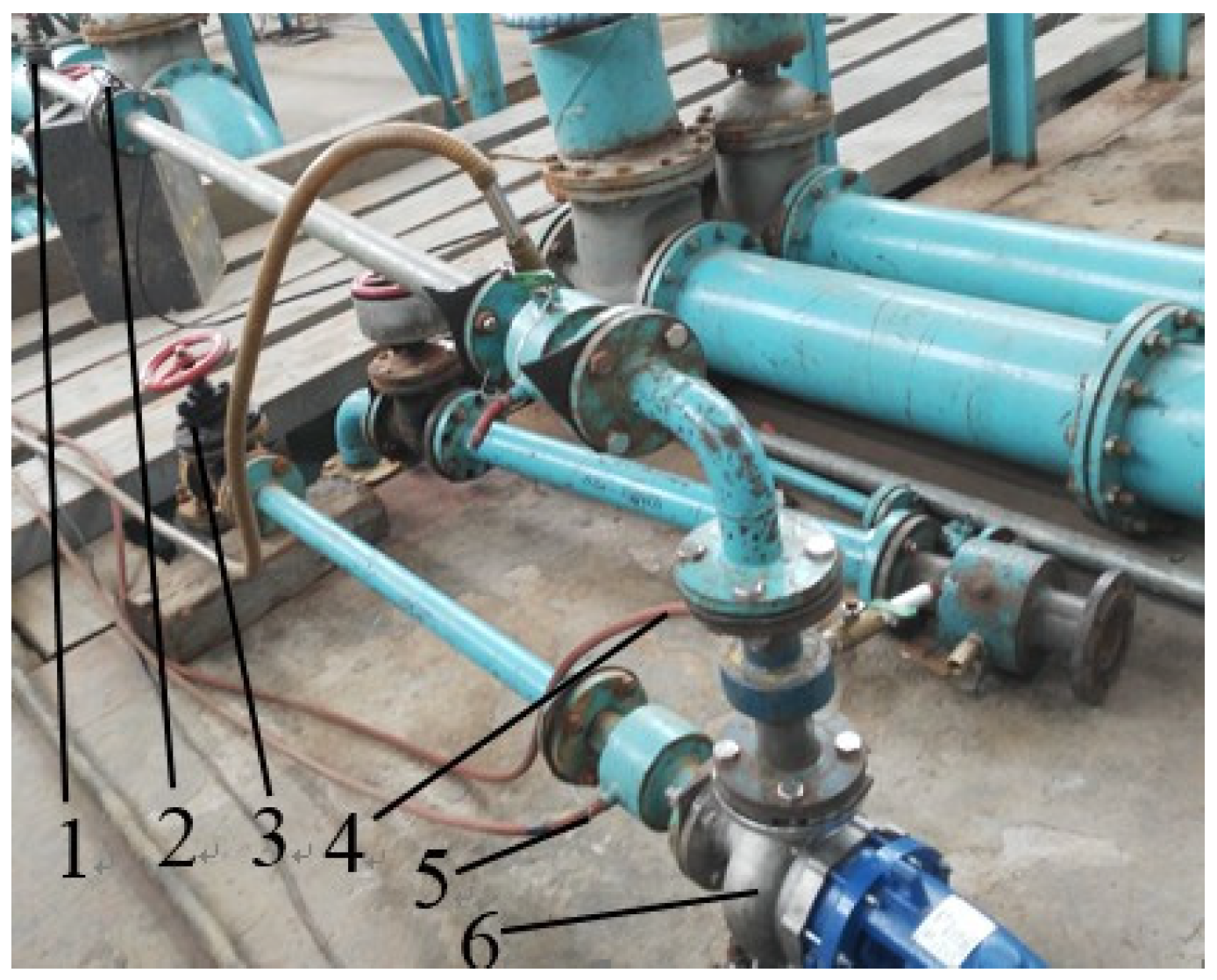
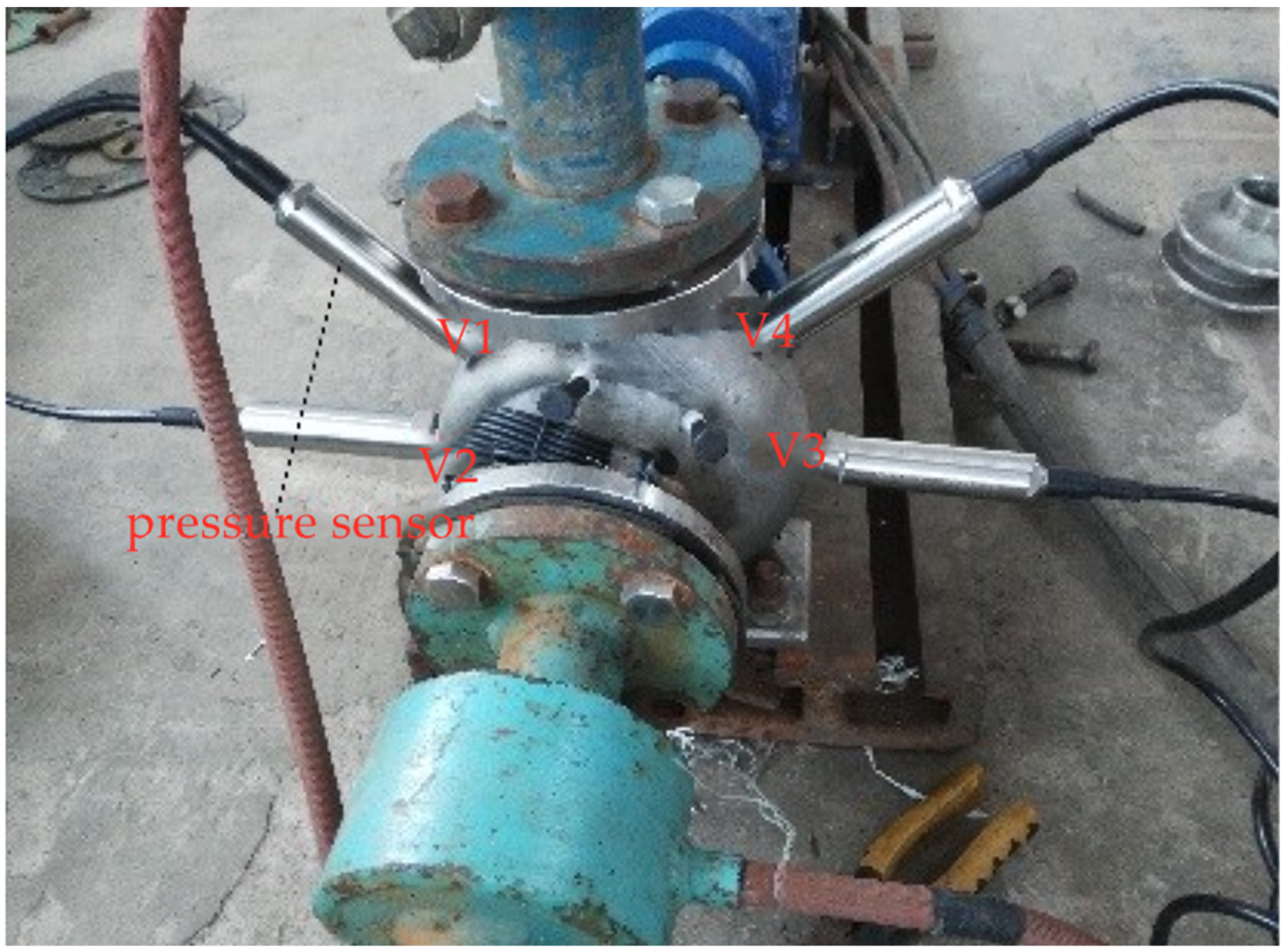

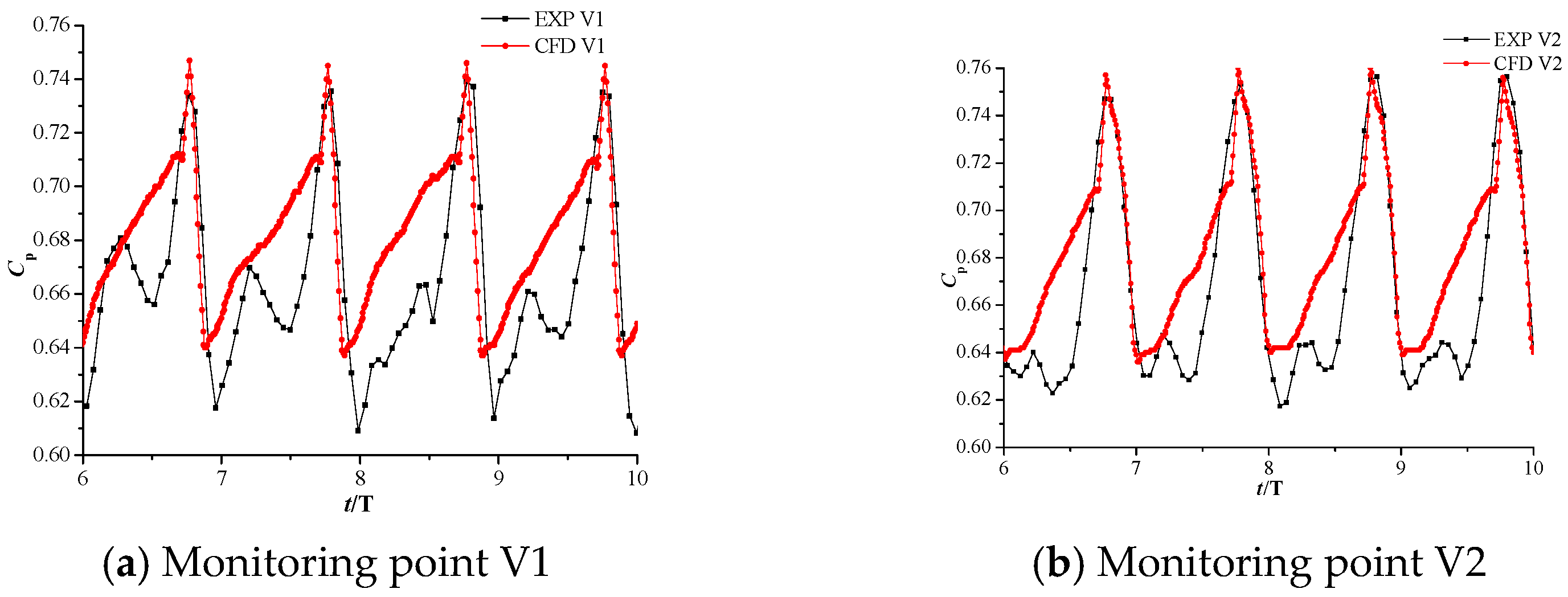
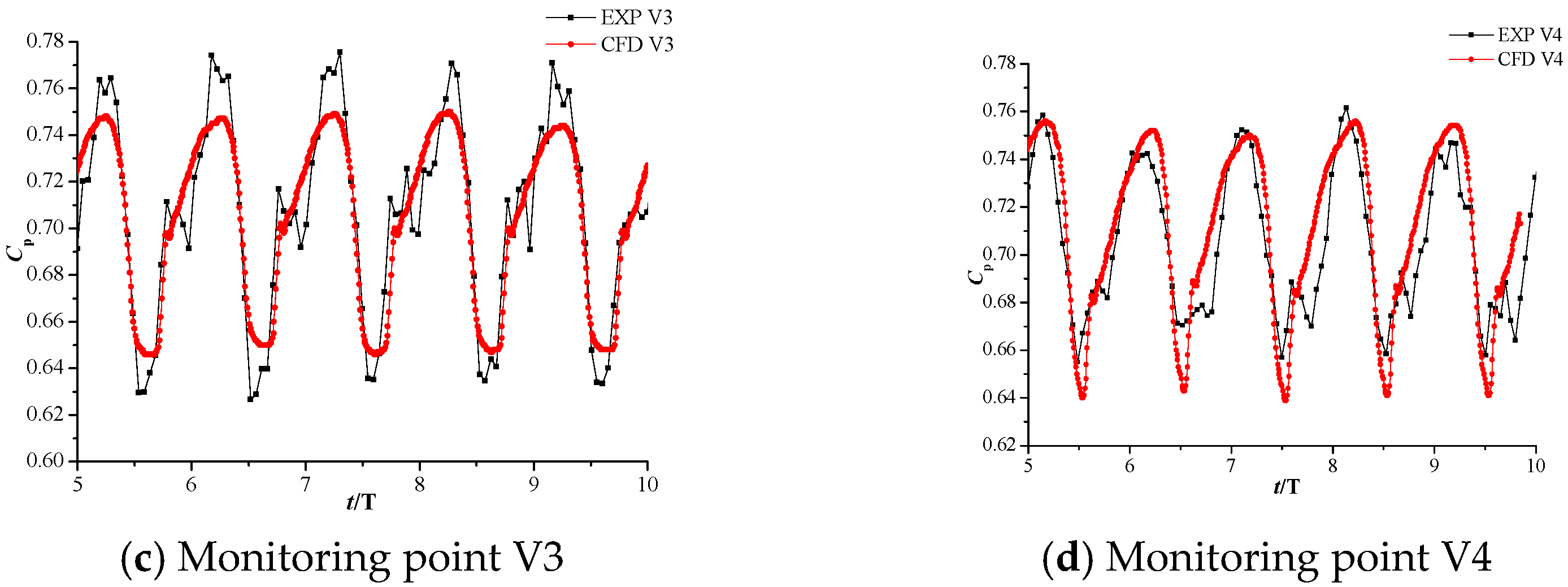



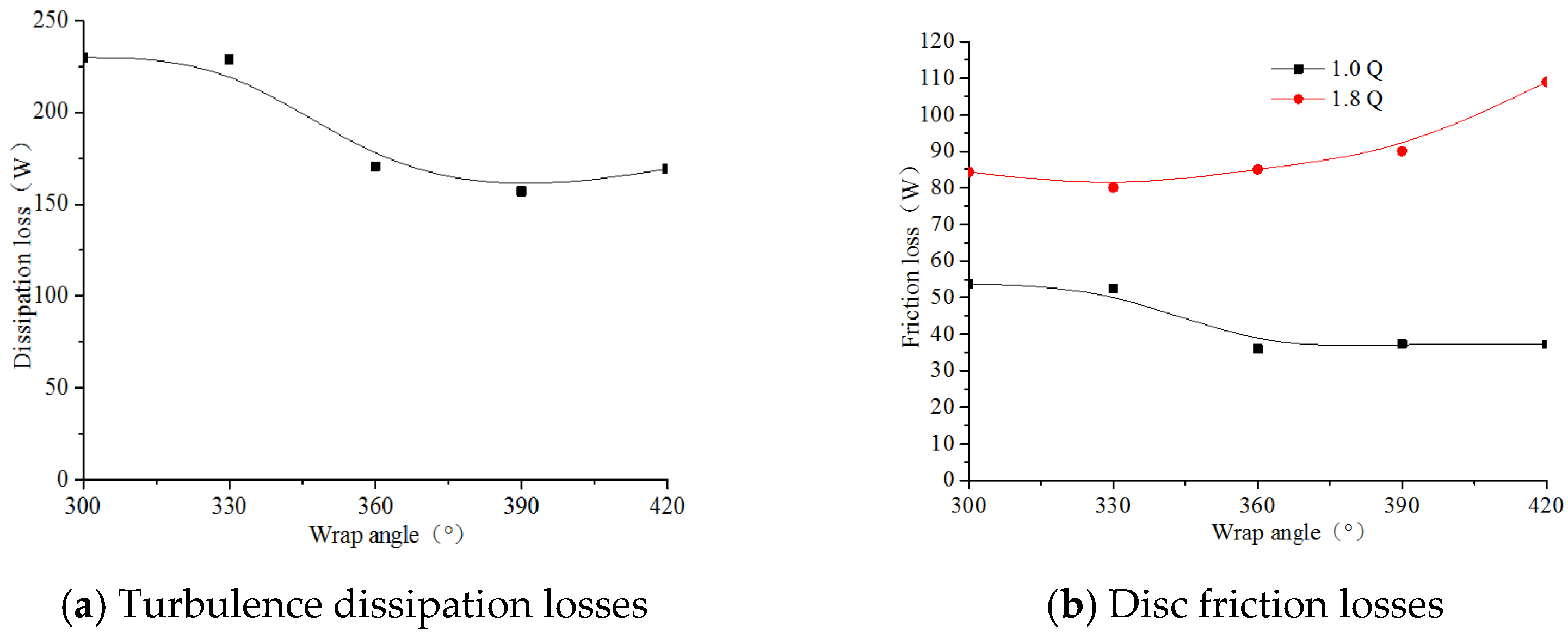

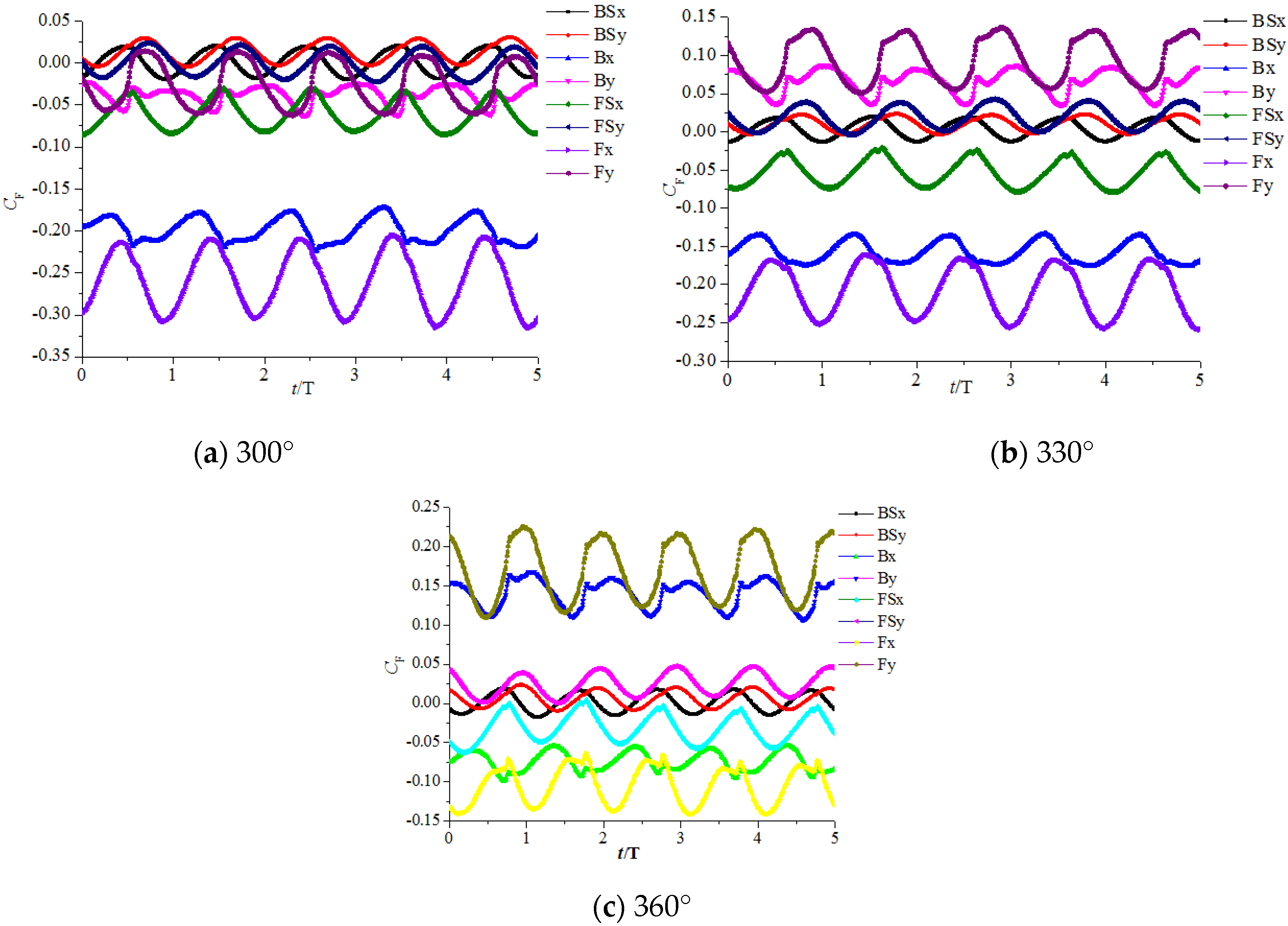
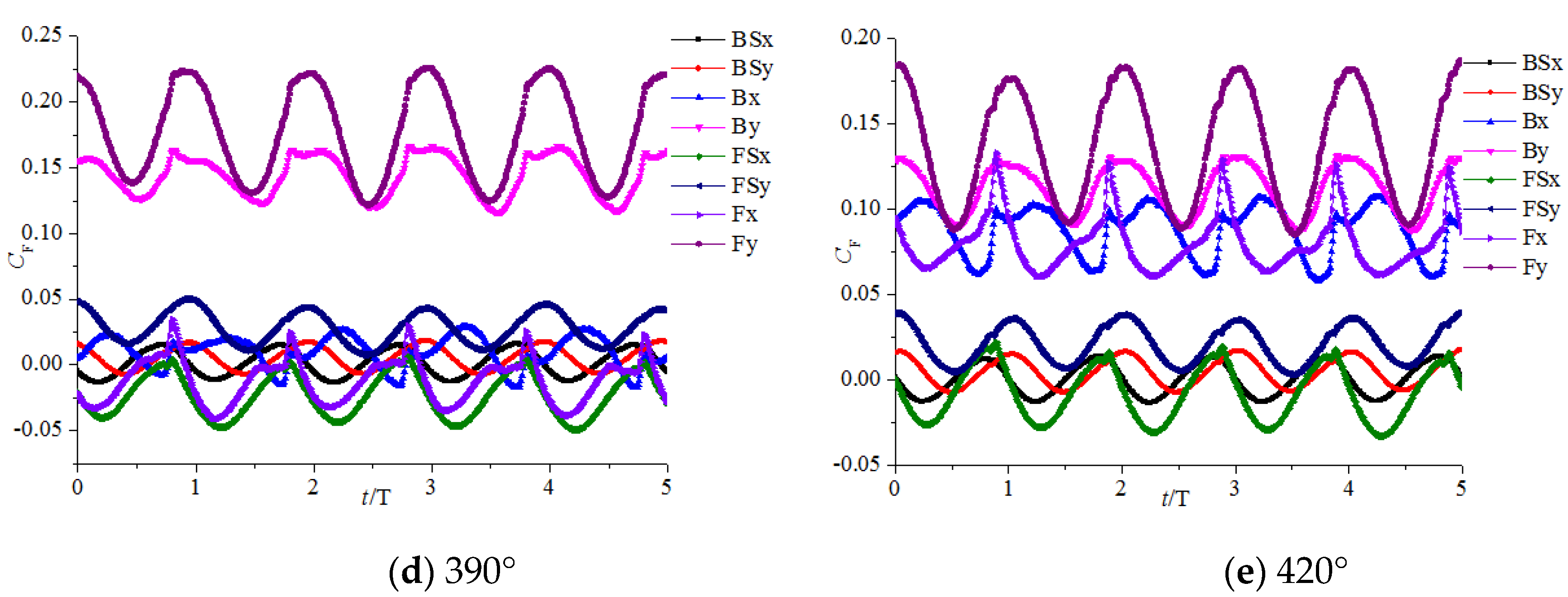
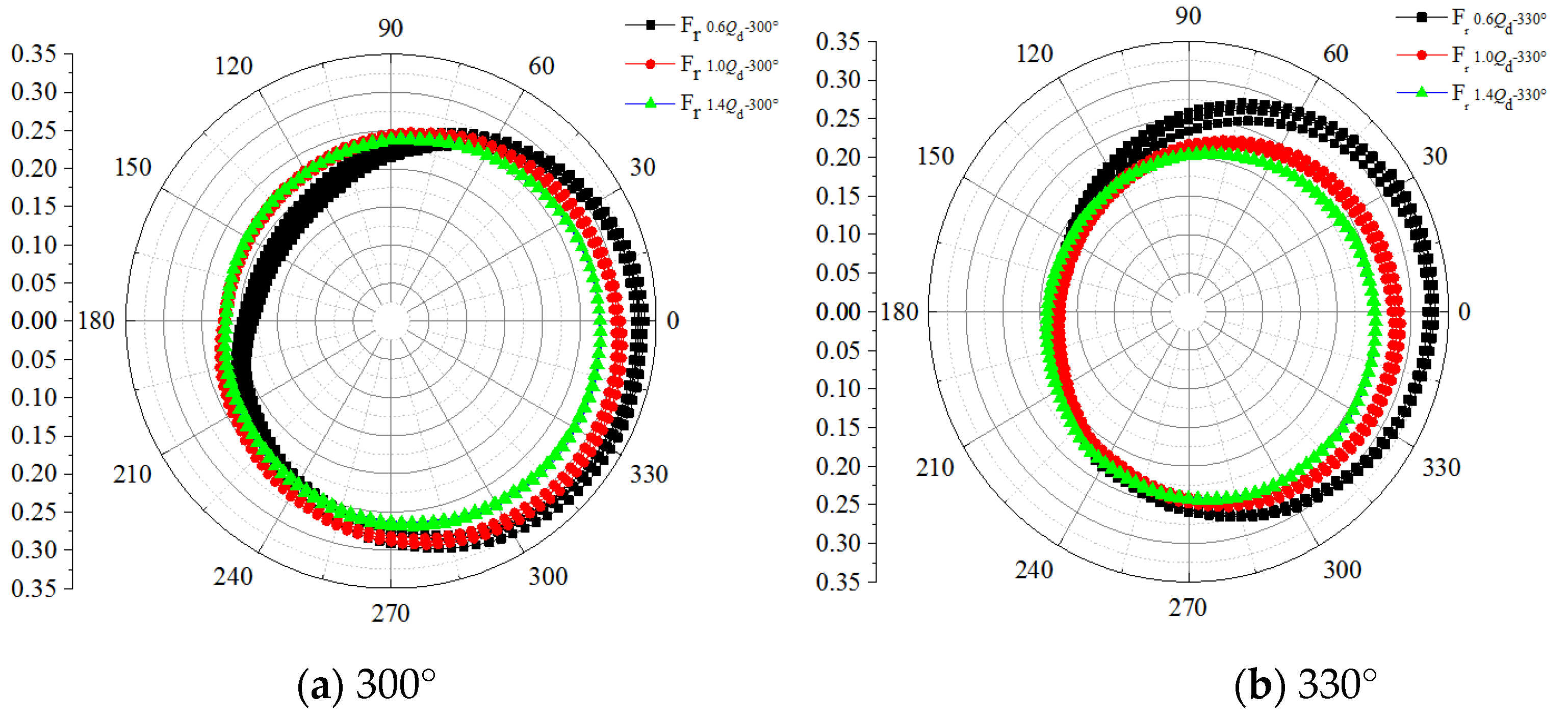
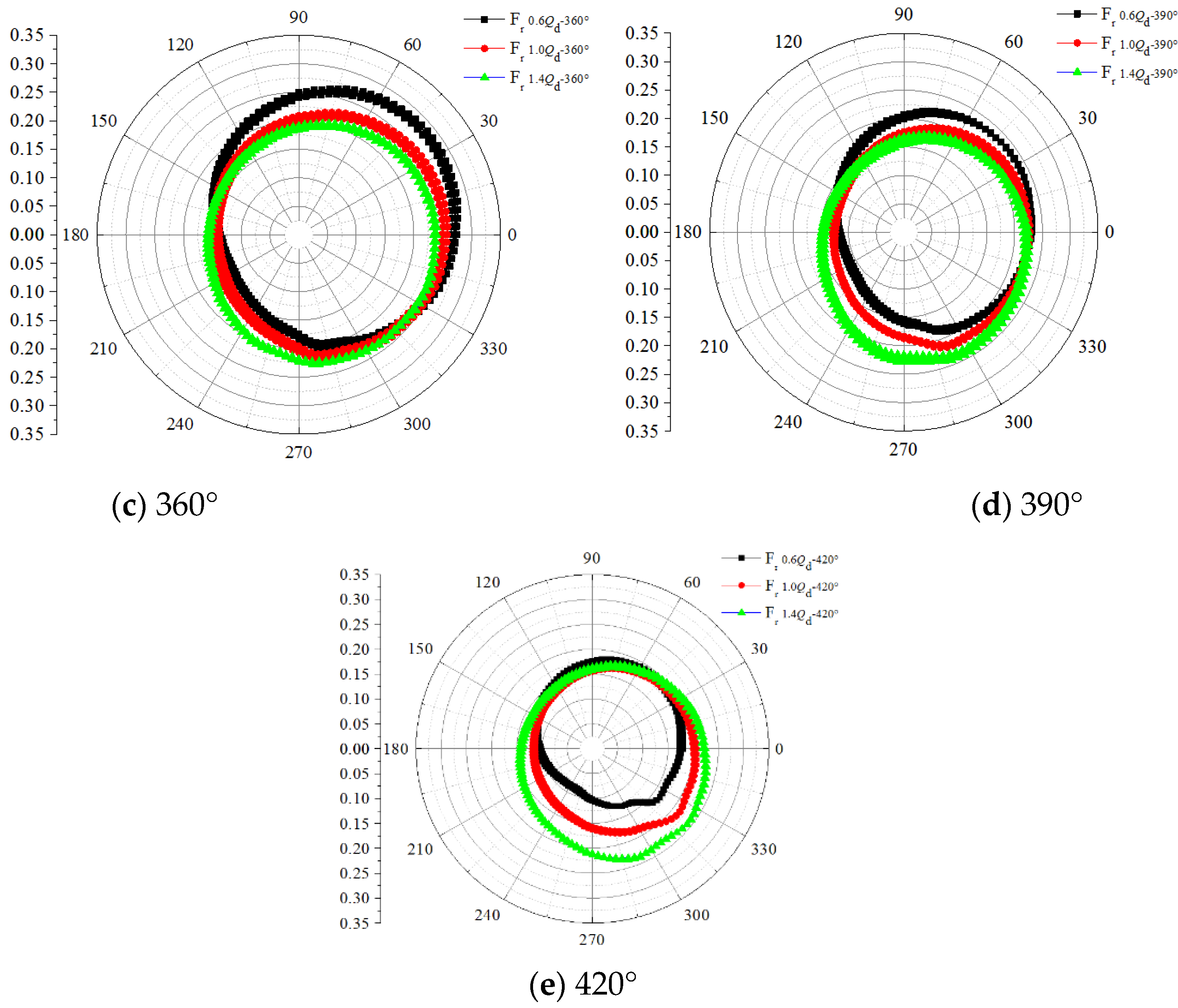







| Main Parameters | Value |
|---|---|
| Inlet diameter of impeller, Dj (mm) | 45 |
| Outlet diameter of impeller, D2 (mm) | 125 |
| Outlet width of impeller, b2 (mm) | 30 |
| Blade wrap angle, φ (°) | 360 |
| Inlet diameter of volute, D3 (mm) | 135 |
| Inlet width of volute, b3 (mm) | 46 |
| Blade outlet angle, β2 (°) | 18 |
Publisher’s Note: MDPI stays neutral with regard to jurisdictional claims in published maps and institutional affiliations. |
© 2021 by the authors. Licensee MDPI, Basel, Switzerland. This article is an open access article distributed under the terms and conditions of the Creative Commons Attribution (CC BY) license (https://creativecommons.org/licenses/by/4.0/).
Share and Cite
Tan, L.; Yang, Y.; Shi, W.; Chen, C.; Xie, Z. Influence of Blade Wrap Angle on the Hydrodynamic Radial Force of Single Blade Centrifugal Pump. Appl. Sci. 2021, 11, 9052. https://doi.org/10.3390/app11199052
Tan L, Yang Y, Shi W, Chen C, Xie Z. Influence of Blade Wrap Angle on the Hydrodynamic Radial Force of Single Blade Centrifugal Pump. Applied Sciences. 2021; 11(19):9052. https://doi.org/10.3390/app11199052
Chicago/Turabian StyleTan, Linwei, Yongfei Yang, Weidong Shi, Cheng Chen, and Zhanshan Xie. 2021. "Influence of Blade Wrap Angle on the Hydrodynamic Radial Force of Single Blade Centrifugal Pump" Applied Sciences 11, no. 19: 9052. https://doi.org/10.3390/app11199052






